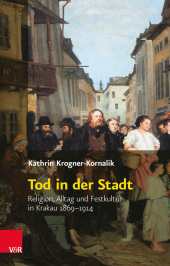 Neuerscheinungen 2015Stand: 2020-02-01 |
Schnellsuche
ISBN/Stichwort/Autor
|
Herderstraße 10
10625 Berlin
Tel.: 030 315 714 16
Fax 030 315 714 14
info@buchspektrum.de |

Kathrin Krogner-Kornalik
Tod in der Stadt
Religion, Alltag und Festkultur in Krakau 1869-1914
2015. 310 S. mit 3 Abb. 23.2 cm
Verlag/Jahr: VANDENHOECK & RUPRECHT 2015
ISBN: 3-525-31026-9 (3525310269)
Neue ISBN: 978-3-525-31026-7 (9783525310267)
Preis und Lieferzeit: Bitte klicken
Das 19. Jahrhundert bedeutete einen Wendepunkt im Umgang mit dem Tod. Während der Tod der Vielen aus dem öffentlichen Raum verschwand, gewann das Gedenken an den Tod von Nationalhelden eine wachsende Bedeutung. Die dabei wirksamen Dynamiken zwischen religiösen und politischen Institutionen sind bisher kaum erforscht. Dies leistet die Studie am Beispiel Krakaus, indem sie eine transkonfessionelle Perspektive einnimmt. Zentrale Aspekte sind der Wandel der Begräbniskultur, die Rationalisierung und Professionalisierung des Umgangs mit dem Tod und die Rolle der Religionsgemeinschaften in diesen Prozessen.
Shifts in the death culture of Krakow in the 19th century.
This study takes an all-faith look at the relationship between the religious and secular processes in the commemoration of the dead, using the example of Krakow.
The 19th century marks a major turning point in the way society dealt with death. On the one hand, deaths in the broad population disappeared from the public sphere, whereas on the other hand the commemoration of the death of national heroes took on a much greater meaning. The dynamics of these changes in light of religious and political institutions has received little research attention. This study looks at the example of Krakow and takes an all-faith perspective. The central aspects examined are the changes in the burial culture, the rationalization and professionalization when dealing with death, and the role of the various religious communities in these processes.
Death remains a mystery. Since death and along with it the question of a life thereafter is at the heart of most religions, it is good starting point for a comparative religious study. During the 19th century both the notion and the handling of death and dying went through significant changes in Europe. It was no longer only the religious communities and close relatives who were responsible for dealing with the dying and the deceased. My book examines the role that religious communities - above all the Catholic Church and the Jewish community - played in these changes. What was the role of religious authorities? How did laypeople react? A case study taking a closer look at 19th-century Cracow shall help to answer these questions. Especially in cities it was common that different religious groups and people with different worldviews lived close to each other. Such a coexistence was typical of the religious landscape in Poland. Nevertheless, comparative studies of religous life in Poland are still rare. One of the cities where Catholics and Jews lived together was Cracow. For both groups, the city had an additional symbolic meaning: Cracow was not only an important religious place, but a reference point for Polish nationalism through the 19th century. Cracow as a site of Polish historical heritage was a significant point for a national pathos which expressed itself among others as a political cult of the dead. Be it the political cult of the dead or death in everyday life, they both have in common that they raise questions both for secular and religious authorities. It is this interplay my book examines thereby analysing the religious content of modernity.


